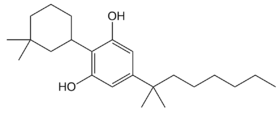O-1871
Appearance
 | |
| Clinical data | |
|---|---|
| ATC code |
|
| Legal status | |
| Legal status |
|
| Identifiers | |
| |
| CAS Number | |
| PubChem CID | |
| ChemSpider | |
| UNII | |
| CompTox Dashboard (EPA) | |
| Chemical and physical data | |
| Formula | C23H38O2 |
| Molar mass | 346.555 g·mol−1 |
| 3D model (JSmol) | |
| |
| |
O-1871 is a potent cannabinoid agonist which was invented by Billy R Martin and Raj K Razdan at Organix Inc in 2002. It has a CB1 receptor affinity of 2.0 nM and a CB2 receptor affinity of 0.3 nM.[1] Structurally, O-1871 is a cyclohexylphenol derivative related to CP 47,497,[2] and so is illegal in some jurisdictions where CP 47,497 and its derivatives are banned. However the 3,3-dimethylcyclohexyl substituent of O-1871 can be replaced by various other groups, producing other potent compounds such as the cycloheptyl derivative O-1656 and the 2-adamantyl derivative O-1660, as well as the corresponding 3,5-dichlorophenyl derivative,[3] which are not cyclohexylphenol derivatives.


See also
[edit]References
[edit]- ^ WO application 03091189, Martin BR, Razdan RK, "Cannabinoids", published 6 November 2003, assigned to University of Virginia
- ^ Debruyne D, Le Boisselier R (2015). "Emerging drugs of abuse: current perspectives on synthetic cannabinoids". Substance Abuse and Rehabilitation. 6: 113–29. doi:10.2147/SAR.S73586. PMC 4622447. PMID 26543389.
- ^ US application 2004087590, Lai XZ, Lu D, Makriyannis A, "Novel biphenyl and biphenyl-like cannabinoids", published 6 May 2004, assigned to University of Connecticut
